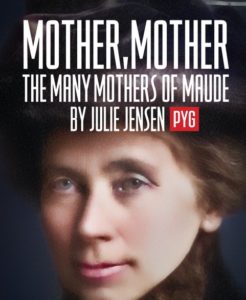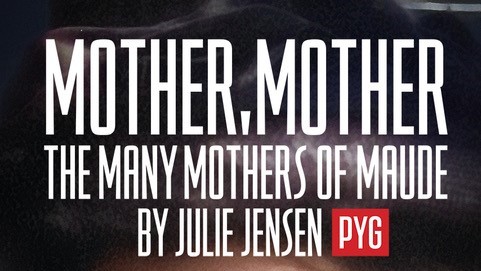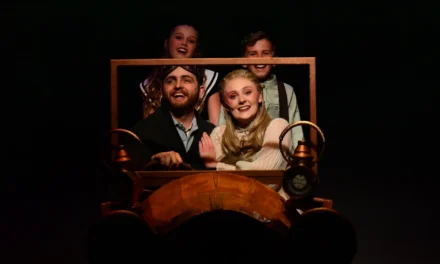SALT LAKE CITY — PYGmalion Productions’ Mother, Mother: The Many Mothers of Maude is a beautiful story about pursuing our dreams and aspirations while accepting the often-times disappointing realities of life. It reminds us of the power of friendship and illustrates the complexities and similarities of the mother daughter relationship from one generation to the next.

Show closes November 19, 2022
Written by Julie Jensen, Mother, Mother is the mostly true story of Utah native Annie Adams (performed by Colleen Baum) and her desire to be a stage actress. Despite her mother Julia Adams’s (performed by Barb Gandy) hopes that she walk a more traditional path, Annie takes her ambitions and young daughter Maude around the country. The two perform at mining camps and other gaudy theaters before eventually arriving in New York. While in New York, Annie is forced to accept that it is Maude (performed by Nicole Finney) and not her who has achieved stardom. This realization causes Annie to examine her place in the theatre world and the direction in which she wants to take her life.
Fran Pruyn directed this small yet powerful ensemble to perfection. Baum, who was in every scene of the 90-minute production, was exceptionally phenomenal. Her delivery left no room for interpretation as to what was important to her character, and she did so with a strength that never left the stage. That strength played particularly well opposite Gandy’s more reserved demeanor as the mother and daughter struggled to understand each other. The script mentioned at times that Julia never added flooring to her house, which Annie found inconceivable. One scene of significance was when Annie s

Left to right: Nicole Finney as Maude, Barb Gandy as Julia, Collen Baum as Annie
uggested she live with her mother whose eyesight was beginning to fail. Julia agreed so long as the dirt floor was never mentioned. The dirt floor seemed to symbolize how the two characters could coexist despite their differences. It was a beautiful exchange between Baum and Gandy that showed Julia had come to terms with her daughter’s decisions and wanted that same respect in return.
One enjoyable aspect of Jensen’s script was how it naturally allowed for comparing the relationship between Annie and Julia to Annie and Maude. As a mother, Annie seemed reluctant to accept how the world was changing and wanted to cling to the expectations and visions she had set for her daughter. Annie was living vicariously through Maude, and she struggled to understand why her daughter’s dreams didn’t align with her own. Finney’s performance was outstanding as she delivered with strength her exchanges with Baum so much so that it was easy to believe the pair were mother and daughter. The story exemplified the notion that while the details may differ, the mother daughter relationship can be quite similar from one generation to the next.
Another relationship examined in Mother, Mother was that of friendship. Annie’s friendship with Martha Hughes Cannon (performed by Tamara Howell) was superbly depicted. The two women take different paths into adulthood, but those variations never hinder the relationship. In one instance, Annie reaches out to Martha for help when she finds herself unexpectedly pregnant. Another is when Martha reluctantly seeks financial help from Annie so she can flee the country. While the two may not have always agreed with the other’s choices, Baum and Howell beautifully illustrated how the two character’s relationships can ebb and flow and evolve throughout the human experience. The final scene, as Martha is comforting Annie during her final moments, was emotional and exquisite.
There were a handful of male roles throughout the production, all of which were performed by Darryl Stamp. Stamp portrayed everyone from Brigham Young (or Uncle Big as many called him) to a US Senator to a farmer. One scene that was most enjoyable was between Stamp as Senator Arthur Brown and Annie. The two are engaged in an illicit affair and have met in public to discuss their situation. While seated on a bench, the two keep their backs together fearing if they’re seen looking at each other their affair might become public. Stamp and Baum rotated around the bench as they struggled to not look at each other. The almost silliness of the actors twisting around the bench while delivering serious dialogue added a layer of depth to the scene. The direction of this scene was much appreciated by me.
The production staff of Mother, Mother did outstanding work. Costumer designer Maddiey Howell-Wilkins had an important role in providing details that helped illustrate the passing of time. Subtle changes to a character’s costume, a favorite being the variety of hats, helped indicate that a character had aged or had entered a new phase of life. Stage manager Jennie Pett and set designer Allen Smith made smart and effective choices relating to props. Minimal props allowed for efficient scene changes and keeping the focal point on the dialogue. Sound design by Mikal Troy Klee was flawlessly executed, with details such as a horse and carriage effect that added to the quality of the scene. Light design by Pilar I was the most enjoyable technical aspect of the production. The actors’ silhouettes in front of the large back drop that rotated through bold colors was so visually pleasing. It was dramatic without being aggressive.
Mother, Mother: The Many Mothers of Maude is a brilliant production. Every aspect of the play from the script to the acting to the technical designs made for an experience you won’t soon forget.





